WooCommerce comes with several shortcodes that can be used to insert content inside posts and pages.
Page Shortcodes
- – shows the cart page
Your cart is currently empty.
- – shows the checkout page
- – shows the user account page
Login
- – shows the order tracking form
In most cases, these shortcodes will be added to pages automatically via our onboarding wizard and do not need to be used manually.
Cart
Used on the cart page, the cart shortcode displays cart content and interface for coupon codes and other cart bits and pieces.
Args: none
Your cart is currently empty.
Checkout
Used on the checkout page, the checkout shortcode displays the checkout process.
Args: none
My Account
Shows the ‘my account’ section where the customer can view past orders and update their information. You can specify the number of orders to show. By default, it’s set to 15 (use -1 to display all orders.)
Args:
array( 'current_user' => '' )
Login
Order Tracking Form
Lets a user see the status of an order by entering their order details.
Args: none
Products
The products shortcode is one of our most robust shortcodes, which can replace various other strings used in earlier versions of WooCommerce. For WooCommerce version 3.1 and lower, please use this document instead.
The shortcode allows you to display products by post ID, SKU, categories, attributes, with support for pagination, random sorting and product tags, replacing the need for multiples shortcodes such as: , , , , , , and , which are needed in versions of WooCommerce below 3.2. Review the examples below.
Available Product Attributes
The following attributes are available to use in conjunction with the shortcode. They have been split into sections for primary function for ease of navigation, with examples below.
Display Product Attributes
limit– The number of products to display. Defaults to and-1(display all) when listing products, and-1(display all) for categories.columns– The number of columns to display. Defaults to4.paginate– Toggles pagination on. Use in conjunction withlimit. Defaults tofalseset totrueto paginate .orderby– Sorts the products displayed by the entered option. One or more options can be passed by adding both slugs with a space between them. Available options are:date– The date the product was published.id– The post ID of the product.menu_order– The Menu Order, if set (lower numbers display first).popularity– The number of purchases.rand– Randomly order the products on page load (may not work with sites that use caching, as it could save a specific order).rating– The average product rating.title– The product title. This is the defaultorderbymode.
skus– Comma separated list of product SKUs.category– Comma separated list of category slugs.tag– Comma separated list of tag slugs.order– States whether the product ordering is ascending (ASC) or descending (DESC), using the method set inorderby. Defaults toASC.class– Adds an HTML wrapper class so you can modify the specific output with custom CSS.on_sale– Retrieve on sale products. Not to be used in conjunction withbest_sellingortop_rated.best_selling– Retrieve best selling products. Not to be used in conjunction withon_saleortop_rated.top_rated– Retrieve top rated products. Not to be used in conjunction withon_saleorbest_selling.
Content Product Attributes
attribute– Retrieves products using the specified attribute slug.terms– Comma separated list of attribute terms to be used withattribute.terms_operator– Operator to compare attribute terms. Available options are:AND– Will display products from all of the chosen attributes.IN– Will display products with the chosen attribute. This is the defaultterms_operatorvalue.NOT IN– Will display products that are not in the chosen attributes.
tag_operator– Operator to compare tags. Available options are:AND– Will display products from all of the chosen tags.IN– Will display products with the chosen tags. This is the defaulttag_operatorvalue.NOT IN– Will display products that are not in the chosen tags.
visibility– Will display products based on the selected visibility. Available options are:visible– Products visibile on shop and search results. This is the defaultvisibilityoption.catalog– Products visible on the shop only, but not search results.search– Products visible in search results only, but not on the shop.hidden– Products that are hidden from both shop and search, accessible only by direct URL.featured– Products that are marked as Featured Products.
category– Retrieves products using the specified category slug.tag– Retrieves products using the specified tag slug.cat_operator– Operator to compare category terms. Available options are:AND– Will display products that belong in all of the chosen categories.IN– Will display products within the chosen category. This is the defaultcat_operatorvalue.NOT IN– Will display products that are not in the chosen category.
ids– Will display products based off of a comma separated list of Post IDs.skus– Will display products based off of a comma separated list of SKUs.
*If the product is not showing, make sure it is not set to Hidden in the Catalog Visibility.

Special Product Attributes
These attributes cannot be used with the “Content Attributes” listed above, as they will likely cause a conflict and not display. You should only use one of the following special attributes.
best_selling– Will display your best selling products. Must be set totrue.on_sale– Will display your on-sale products. Must be set totrue.
Product Category shortcodes
These two shortcodes will display your product categories on any page.
– Will display products in a specified product category.– Will display all your product categories.
Product Category attributes
ids– Specify specific category ids to be listedlimit– The number of categories to displaycolumns– The number of columns to display. Defaults to 4hide_empty– The default is “1” which will hide empty categories. Set to “0” to show empty categoriesparent– Set to a specific category ID if you would like to display all the child categoriesorderby– The default is to order by “name”, can be set to “id”, “slug”, or “menu_order”. If you want to order by the ids you specified then you can useorderby="include"order– States whether the category ordering is ascending (ASC) or descending (DESC), using the method set inorderby. Defaults toASC.
Example Product Scenarios
In the following scenarios, we’ll use an example clothing store.
Scenario 1 – Random Sale Items
I want to display four random on sale products.
This shortcode explicity states four products with four columns (which will be one row), showing the most popular on-sale items. It also adds a CSS class quick-sale, which I can modify in my theme.
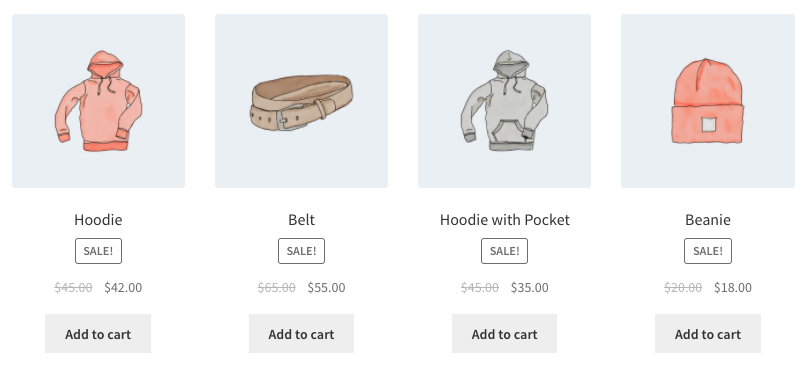
Scenario 2 – Featured Products
I want to display my featured products, two per row, with a maximum of four items.
This shortcode says up to four products will load in two columns, and that they must be featured. Although not explicitly stated, it uses the defaults such as sorting by title (A to Z).
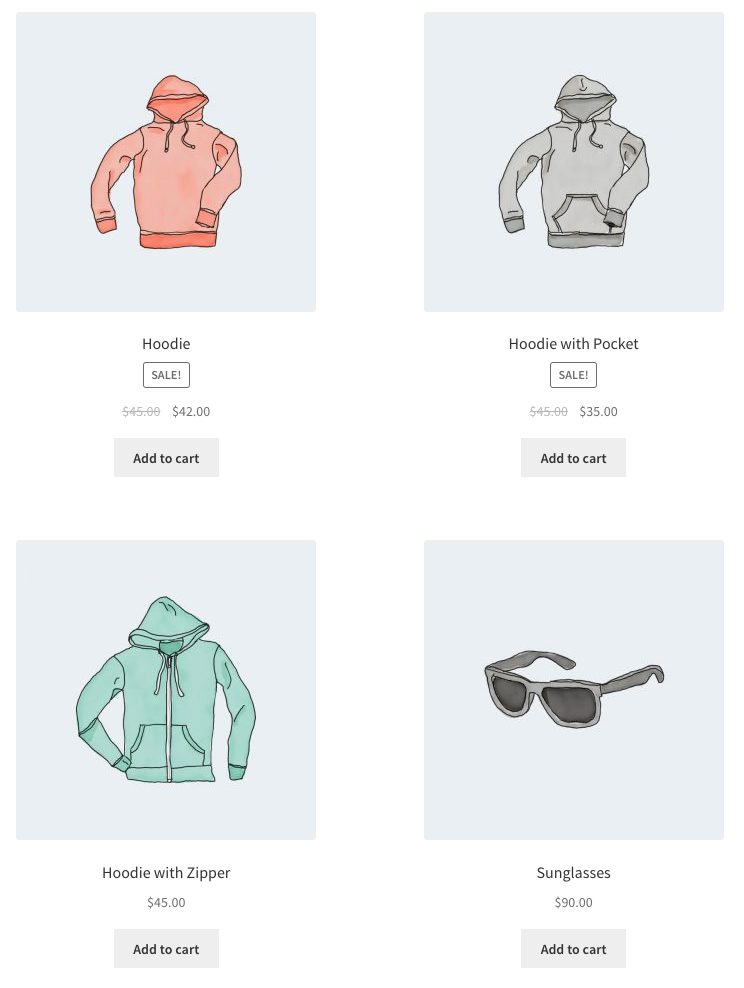
Scenario 3 – Best Selling Products
I want to display my three top best selling products in one row.
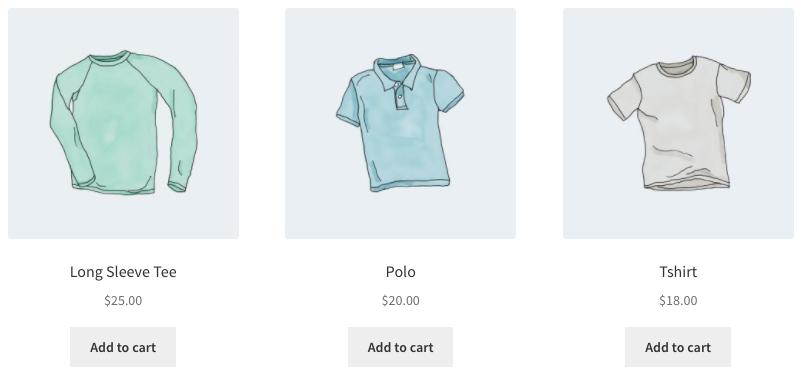
Scenario 4 – Newest Products
I want to display the newest products first – four products across one row. To accomplish this, we’ll use the Post ID (which is generated when the product page is created), along with the order and orderby command. Since you can’t see the Post ID from the frontend, the ID#s have been superimposed over the images.
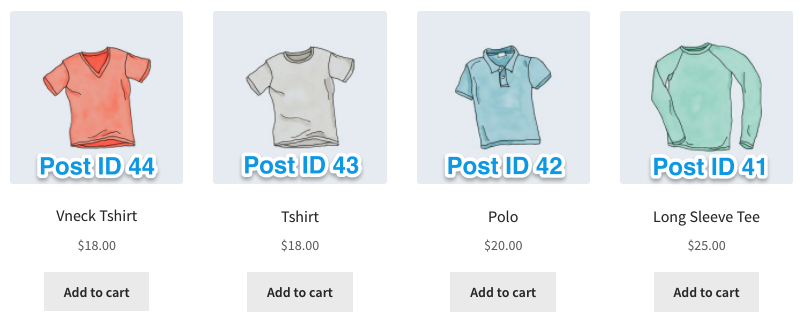
Scenario 5 – Specific Categories
I only want to display hoodies and shirts, but not accessories. I’ll use two rows of four.
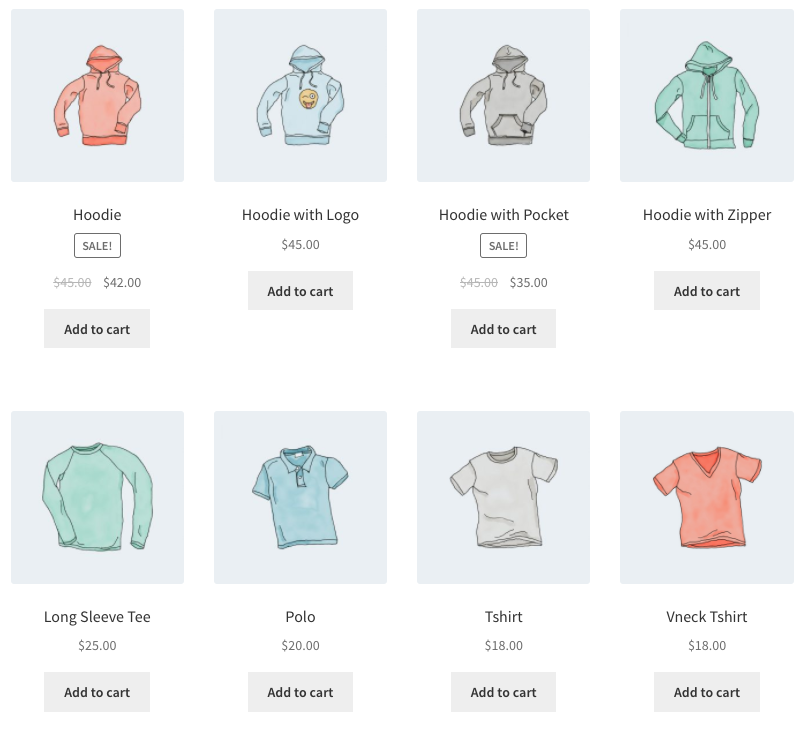
Alternatively, I only want to display products not in those categories. All I need to change is the cat_operator to NOT IN.
Note that even though the limit is set to 8, there are only four products that fit that criteria, so four products are displayed.
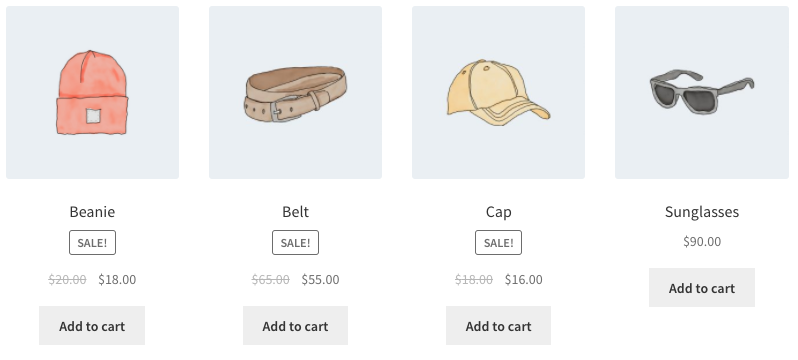
Scenario 6 – Attribute Display
Each of the clothing items has an attribute, either “Spring/Summer” or “Fall/Winter” depending on the appropriate season, with some accessories having both since they can be worn all year. In this example, I want three products per row, displaying all of the “Spring/Summer” items. That attribute slug is season, and the attributes are warm and cold. I also want them sorted from the newest products to the oldest.
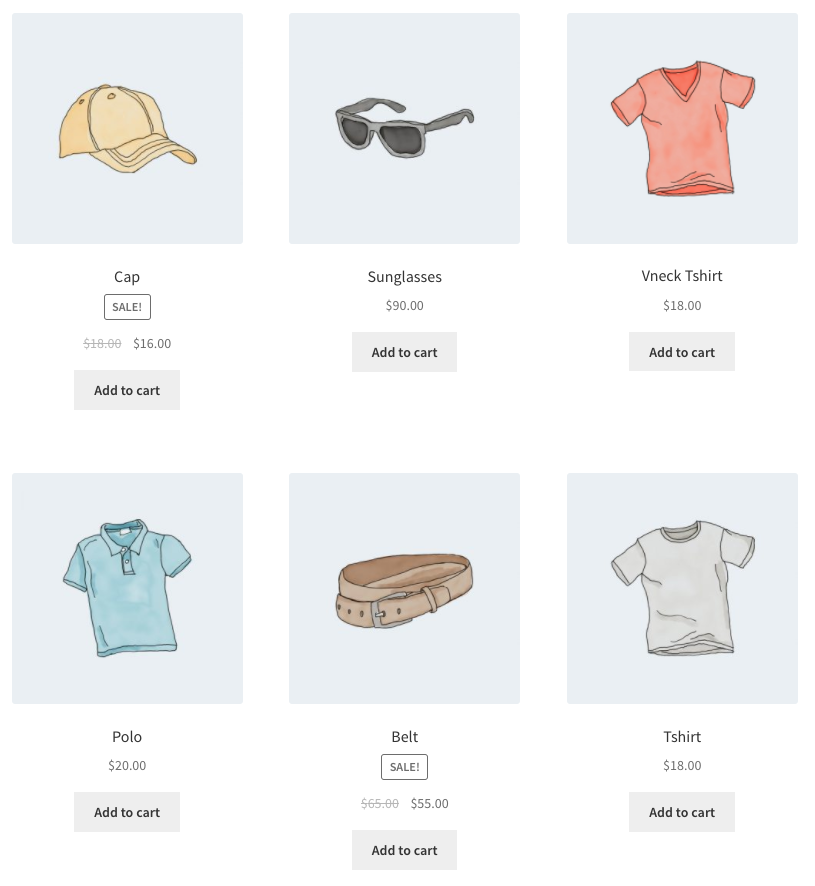
Alternatively, if I wanted to display exclusively cold weather products, I could add NOT IN as my terms_operator:
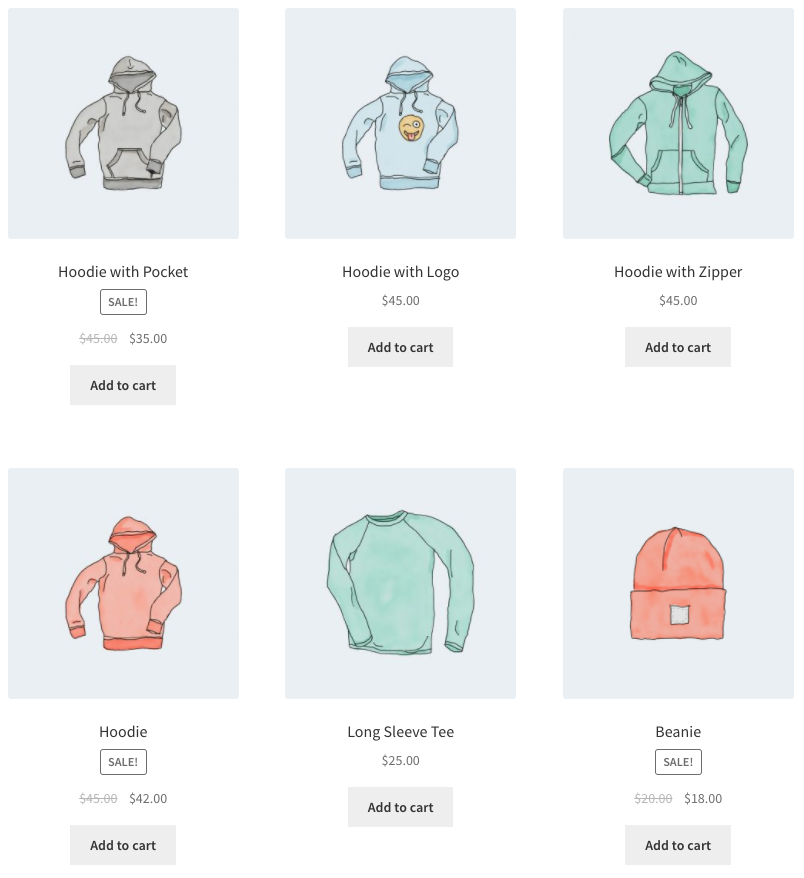
Note that by using NOT IN, I exclude products that are both in “Spring/Summer” and “Fall/Winter”. If I wanted to show all cold-weather appropriate gear including these shared accessories, I would change the term from warm to cold.
Scenario 7 – Show Top Level Categories Only
Imagine you only wanted to show top level categories on a page and exclude the sub categories, well it’s possible with the following shortcode.
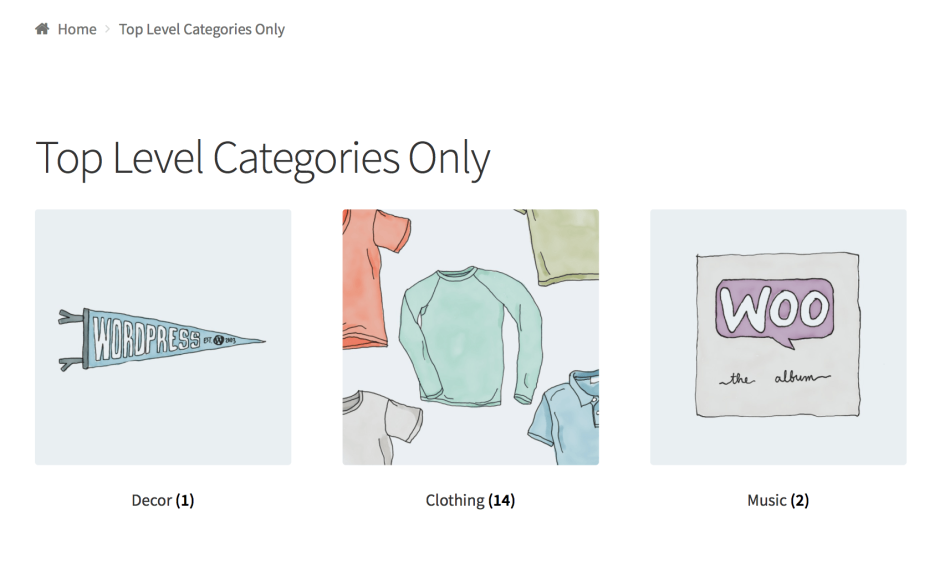
Scenario 8 – Show Only Products With tag “hoodie”
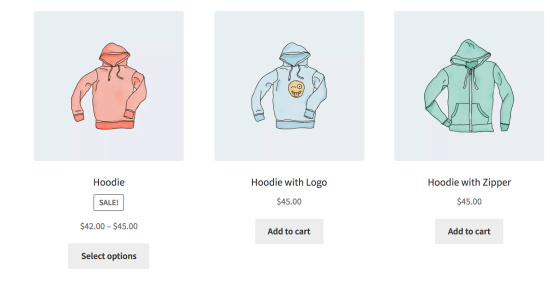
Sorting Products by Custom Meta Fields
When using the Products shortcode, you can choose to order products by the pre-defined values above. You can also sort products by custom meta fields using the code below (in this example we order product by price):
add_filter( 'woocommerce_shortcode_products_query', 'woocommerce_shortcode_products_orderby' );
function woocommerce_shortcode_products_orderby( $args ) {
$standard_array = array('menu_order','title','date','rand','id');
if( isset( $args['orderby'] ) && !in_array( $args['orderby'], $standard_array ) ) {
$args['meta_key'] = $args['orderby'];
$args['orderby'] = 'meta_value_num';
}
return $args;
}
You need to place this snippet in functions.php in your theme folder and then customize by editing the meta_key.
Product Page
Show a full single product page by ID or SKU.
Related Products
List related products.
Args:
array(
'limit' => '12',
'columns' => '4',
'orderby' => 'title'
)
‘limit’ Argument
Add to Cart
Show the price and add to cart button of a single product by ID.
Args:
array(
'id' => '99',
'style' => 'border:4px solid #ccc; padding: 12px;',
'sku' => 'FOO'
'show_price' => 'TRUE'
'class' => 'CSS-CLASS'
'quantity' => '1';
)
Add to Cart URL
Echo the URL on the add to cart button of a single product by ID.
Args:
array(
'id' => '99',
'sku' => 'FOO'
)
Display WooCommerce notifications on non-WooCommerce pages
allows you to show WooCommerce notifications (like, ‘The product has been added to cart’) on non-WooCommerce pages. Helpful when you use other shortcodes, like , and would like the users to get some feedback on their actions.
Troubleshooting Shortcodes
If you correctly pasted your shortcodes and the display looks incorrect, make sure you did not embed the shortcode between <pre> tags. This is a common issue. To remove these tags, edit the page, and click the Text tab:


